Research
I am an evolutionary biologist interested in animal behavior and particular animal communication that is used in the context of reproduction. More specifically, I am fascinated by how environmental factors, such as temperature, day length, or eavesdropping predators cause the expression of different behavioral phenotypes and direct the their evolution.
My lab focuses on two lines of research:
-
Phenotypic plasticity and evolution of mating songs:
Current research:-
We are studying the timing of induction of alternative phenotypes in Neoconocephalus triops.
-
The effect of seasonality on the capacity for call plasticity in the northernmost population of N. triops.
-
The effect of environmental factors on mating songs in Gryllus rubens.
-
Molecular basis of phenotypic plasticity.
-
-
Co-evolution of parasitoids and their hosts
Current research:
Determining host specificity and seasonality of Ormia lineifrons and its katydid hosts.Below I summarize some of the past findings in these research areas and outline potential directions of my research program.
-
The evolutionary significance of phenotypic plasticity in animal communication
I have been studying an exceptional katydid species, Neoconocephalus triops, to answer questions related to phenotypic plasticity and evolution of communication systems. Mating signals and signal recognition have to match for mating and reproduction to occur. Reproductive communication and all involved traits have an extremely high evolutionary potential because changes in any of these traits directly lead to differential reproductive success and can therefore cause rapid evolutionary change and even speciation. In order to avoid mis-matings between species, recognition and mating signal have to be species-specific. As a rule of thumb, each orthopteran species has its own call that is distinguishable from the calls of other species and this call typically does not display permanent phenotypic plasticity (i.e., the ability of one genotype to express different phenotypes in response to differences in the environment). In contrast to this general rule, N. triops in Northern Florida expresses substantially different mating calls in the summer and winter as a result of seasonal differences in day length (Whitesell & Walker 1978). These song differences are of such large magnitude that the two generations have been described as separate species at first.
I studied how female call recognition deals with this substantial season variation of mating calls. I found that female call recognition adapted to the different calls in each season by changing with the seasonal temperature, ultimately matching recognition to summer calls at warm summer temperatures and winter calls at cold winter temperatures. For more information please see Beckers & Schul (2008, 2010).
This species has an exceptional for its vast distribution range: it has been reported to occur from Peru in the South to Ohio in the north. Note that N. triops has only recently extended its range from the tropics to North America. Males in the tropics express only the summer call phenotype, however, I found that males from Puerto Rico and Costa Rica are actually capable of expressing winter calls when reared in short days (Beckers & Schul 2010). Also, female call recognition has evolved after N. triops moved from the tropics to temperate North America as a result of male call plasticity: female preferences from the North American population change much more drastically with ambient temperature than females from tropical populations, resulting in a much better match between male calls and seasonal temperatures, facilitating reproduction in this new environment (Beckers & Schul 2010) and signifying a much rarer case of a female preferences adapting to male signals rather than vice versa.
Current research focuses on the local, northern population of N. triops. Due to the shortened period of warm months necessary to reproduce (compared to Florida), N. triops likely has not enough time for two reproductive seasons per year. Which generation and call phenotype are present in Kentucky are subject to current investigation. Furthermore, we investigate if males in Kentucky may have lost the capacity to express both calls as the result of potential univoltinism (i.e., one generation per year). Overall, this and additional projects will clarify how local environmental conditions interact with phenotypic plasticity, leading to diversification of the communication system along the vast and climatically diverse north-south distribution of N. triops.
Another line of research focuses on identifying the molecular basis of phenotypic plasticity, i.e., the alternative mating calls. This project is being conducted with collaborators are the University of Missouri and West Virginia University. At the moment, we are identifying the timing of the developmental switch point leading to the summer and winter call phenotype in N. triops.
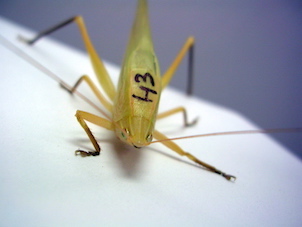
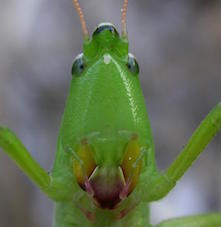
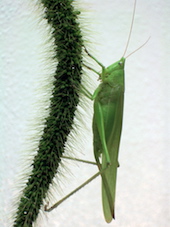
Phenotypic plasticity of Gryllus rubens calls
Aside from Neoconocephalus triops, the field cricket Gryllus rubens also expresses call plasticity. Similar to N. triops, G. rubens in Florida (and also Kentucky) has two generations per year, and male calls change between seasons. However, here development responds to to environmental rearing temperature causing calls to be faster in the fall generation compared to the spring generation(Walker 2000). We are currently exploring this call plasticity in the Kentucky population and will compare our findings to the Florida population. -
Co-evolution of parasitoids and their hosts
The parasitoid fly, Ormia ochracea, eavesdrops on the mating calls of male crickets of the genera Gryllus and Teleogryllus across the southern half of the U.S. and Hawaii. The distribution range of the fly is much vaster than that of each host species. Thus, the fly uses a different host in a different part of its range.
In California, O. ochracea exploits Gryllus lineaticeps as primary host for its larvae. At night, the fly uses the mating calls of the male crickets to locate them and to expel live planidia larvae on and around the cricket. The larvae placed on the cricket burrow into the male, feed on its fat and non-vital organs, develop, and emerge after 7-10 days, killing the host during this process (Adamo et al. 1995). Since males can reproduce multiple times throughout their life, a shortened life span severely reduces the fitness of the infested male. The larvae placed around the stationary male can live for several hours (Beckers et al. 2011) and attack female crickets that approach the singing male. Female crickets that are infested by the larvae share the same fate as the male crickets and can lose a substantial portion of their life time fitness. Importantly, female crickets as well as parasitic flies share the same preferences for male cricket calls: faster chirp rates and longer chirp durations are most attractive to both, which results in an fascinating evolutionary arms race: males that advertise their 'sexiness' to attract females for mating (sexual selection) at the same time increase their risk of being parasitized by fly larvae (natural selection). Females that are attracted to these particularly desirable males also have an increased risk of being parasitized and killed. This parasitoid/host system offers a wonderful opportunity to study the effects of opposing sexual and natural selection on the evolution of host communication and preferences.
I was part of one of the most extensive studies on the interactions between parasitoids and their hosts using 10 cricket populations that varied in parasitism risk (low-risk vs. high-risk populations in California). We examined the effect of parasitism on the evolution of (host) male mating songs and singing activity, and female preferences and responsiveness to male songs, predicting that these traits should have evolved values that reflect a compromise between attracting mates and parasitoids. However, the evolutionary processes turned to be more complex resulting in results vastly different from our predictions: males from high-risk population did not reduce the amount of nightly calling (Beckers & Wagner 2012b), however, female preferences and calls evolved as a result of parasitism (Beckers & Wagner in prep).
Besides these long-term evolutionary consequences of the co-evolutionary arms race between the flies and the crickets, I also studied the immediate effects of parasitoid infestation on the host, finding that calls of infested males do not differ from those of infested males (Beckers & Wagner 2011b), and infested females being less selective for male calls than uninfested females (Beckers & Wagner 2013).
My future research will focus on the different host adaptations to fly parasitism across a vast geographic range. In addition, the katydid Neoconocephalus spec. are the host of a closely-related parasitoid fly, Ormia lineifrons. We recently discovered parasitism of 2+ species of Neoconocephalus in KY and are currently investigating host specificity of O. lineifrons of the local population.
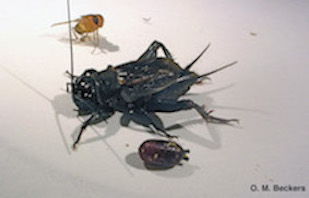
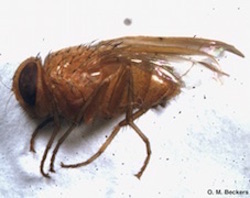
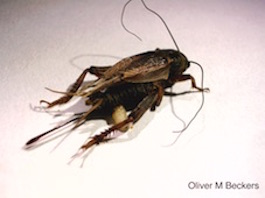
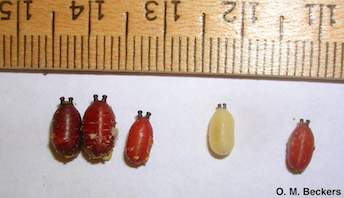
Figures 1-4 (top left to bottom right):
-
Fig.1 Gryllus lineaticeps (cricket, host), Ormia ochracea (fly parasitoid), and Ormia ochracea pupa.
-
Fig.2 Ormia ochracea.
-
Fig. 3 Ormia ochrea larva emerging from female cricket.
-
Fig. 4 Ormia ochracea pupae.
-
-
